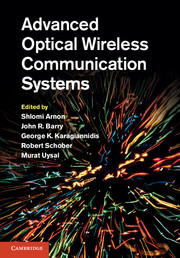14 - Visible-light communications
from Part IV - Applications
Published online by Cambridge University Press: 05 June 2012
Summary
Visible-light communications is the name given to a wireless communication system that conveys information by modulating light that is visible to the human eye. Communications may not be the primary purpose of the light; in many applications the light primarily serves as a source of illumination. Interest in VLC has grown rapidly with the growth of visible-light light emitting diodes (LEDs) for illumination. The motivation is clear: When a room is illuminated by LEDs, why not exploit it to provide communications as well as illumination? This sharing of resources can save electric power and raw materials.
VLC principle
A simple means for achieving visible-light communications is to switch the LED lighting on and off at a speed higher than is perceptible to the human eye. Eyes are organs that can detect changes in light brightness and power when these changes occur over a long time scale, but they cannot perceive light that is switched on and off rapidly, say at 200 Hz or more, depending on the eye. A photodiode, on the other hand, can easily recognize the the rapid on–off modulation. A photodiode is a photodetector that produces an electrical current that is proportional to the optical power that is incident on the photodetector surface. This simple principle makes possible visible-light communication technology that supports both illumination and wireless communication using an LED (see Figure 14.1).
The dual function of illumination and communications means that the user can always recognize a communications area.
- Type
- Chapter
- Information
- Advanced Optical Wireless Communication Systems , pp. 351 - 368Publisher: Cambridge University PressPrint publication year: 2012
- 3
- Cited by



